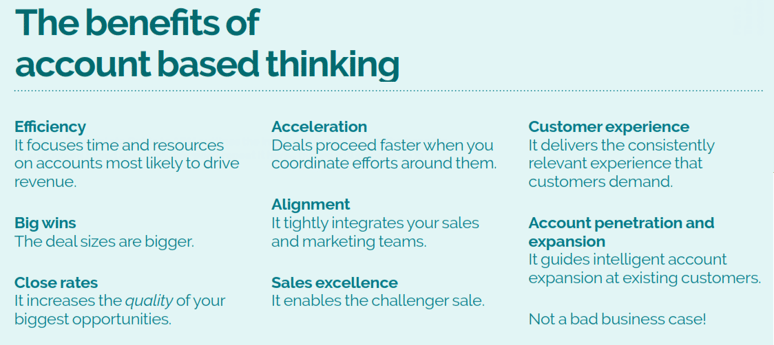 It's 2017 and I’m on a mission to educate the market about the difference between account-centric and account-based thinking. The truth is that most companies don’t understand the distinction. Just drawing a box around a set of accounts and then executing your same old demand generation strategies won't get you to the promised land of larger deals in strategic accounts.
It's 2017 and I’m on a mission to educate the market about the difference between account-centric and account-based thinking. The truth is that most companies don’t understand the distinction. Just drawing a box around a set of accounts and then executing your same old demand generation strategies won't get you to the promised land of larger deals in strategic accounts.
That’s why I’ve asked Jon Miller, Engagio CEO and former Marketo cofounder, to share his thinking. Without further ado, here’s Jon.
---
The B2B landscape is changing, fast.
In 2011, CEB concluded that there are 5.4 decision makers in a B2B sale. Just a few years later, new studies revealed that number has jumped by 30%. There’s even research that indicates as many as 17 decision-makers in enterprise sales. That’s exactly why more and more companies are adopting account-based strategies across their Sales and Marketing teams—it just makes sense to reach out to multiple decision-makers and influencers.
But doing it well goes beyond simple buzzwords; true success requires an orchestrated approach. Call it Account Based Everything. Call it Account-Based Revenue (as The Bridge Group does).
Call it whatever you want – the bottom line is to execute a strategic go-to-market approach that personalizes marketing, sales, and customer success efforts to land and expand at named accounts.

Reaching out to multiple contacts in an account without deep research and personalization isn’t account-based anything. That’s second rate cold-calling from 2004. Successful strategies share six basic processes:
- Select accounts
- Discover and map contacts
- Develop account insights
- Generate account-relevant messaging
- Deliver account-specific interactions
- Orchestrate account-focused plays
Simply contacting multiple prospects within one account skips over steps 2-4, and that makes steps 5 and 6 impossible.
Having Leads isn’t Discovering and Mapping Contacts
With large target companies, it can be challenging to understand the structure of the decision-making team for each buying center. That’s why account-based strategies call for account-specific research to map it out. Once you’ve identified the buying centers, you need to make sure your database has the contact information for each member of the extending buying team.
Since Leads in Salesforce don’t connect to Accounts—even though you might have thousands of the right contacts—they’re useless from an account-centric perspective. You need the ability to automatically map them to the right account. That’s why Lead-to-Account Matching (L2A) is so essential.
Armed with a complete view of your current contacts, the final step here is to augment your existing data with any missing contacts for each of the key personas in the buying committee.
Phone Numbers and Email Addresses aren’t Account Insights
Developing account insights might be the process most crucial to the success of an account-based strategy.
So much depends on understanding the nuances of target accounts and using that insight to make each interaction more relevant. Your team will want to track insights such as:
- The target account’s market—The market dynamics, news, trends, growth drivers and inhibitors, M&A activity, and so on.
- The target company—Their stated strategy, strengths, weaknesses, opportunities and threats; competitors (and which similar companies use your solution already); their organization chart and unique buying centers; which buying centers own your products, which own competitors’ and which are open (whitespace analysis); any recent sales triggers (new funding, new hires, etc.); their culture and values.
- The target personas—The agenda of each member of the buying team; their priorities, prejudices, preferences, styles, tactics; where they’ve worked in the past (and what systems that company used).
- The relationships inside the account—How each key contact relates to the other members of the team; who reports to whom; who holds budgets; who are the influencers, blockers, mobilizers, enablers etc.
- Your connections to the account—Your existing connections to the key contacts; previous deals; customer service experiences; your experience with their close competitors; LinkedIn connections to people you know; university or past company ties.
This kind of information takes time to collect, but lays the foundation for much more fruitful “Challenger Sale” conversations.
Templated Emails aren’t Account-Relevant Messaging
You've done all of the legwork: mapping contacts, gathering insights, and developing personalized content. This is where ABE shines.
- 50% of customers are more likely to purchase from a vendor when they personalize materials to a customer’s specific business issues (ITSMA)
- 75% of executives will read unsolicited marketing materials that contain ideas relevant to their businesses (ITSMA)
The degree of personalization should depend on the tier of the target account and the importance of the specific contact. Simple personalization can be based on the target’s industry and persona. Hyper-personalization calls for bespoke content designed for the specific company.
The rule is pretty simple – high-value targets get high customization, medium-value get medium customization, and lower-value get lower customization. Relevance is at the heart of account-based selling, and it will always get noticed above templated pitches or generic requests to “find the right contact.”
Access to Shared Account Records aren’t Account-Focused Plays
At first glance, it’s easy to assume that if the AEs know which accounts the SDRs are calling on, you’re good. Coordinating account-focused plays requires more than shared access to an account record in CRM.
You need visibility of multiple buyers in the account (decision-makers and influencers) across multiple channels (email, phone, social, direct email, and events) delivered to relevant departments (Marketing, Sales Development, Sales, and Customer Success).
Great plays have strategy behind them. Cross-functional members of the organization working towards a business purpose with clearly defined roles and responsibilities. It is a well-orchestrated and coordinated series of activities and events built around a well thought out theme or message for that account.
When you can execute at that level, the results will always be greater than individual departments working in isolation. If you’ve been trying to cut corners, stop. Back up, slow down, and work cross-functionally to do it right.
- - - - - - - - - - - - - - - -
(Trish here again.) It’s my hope that in 2017, more companies will generate significant revenue from account-based strategies. A great way to keep your finger on the pulse of best practices to pay attention to those, like Engagio, FlipMyFunnel, and Inverta, who are sharing some of the best thinking in the account-based revenue movement.
